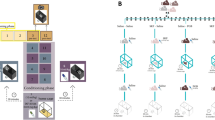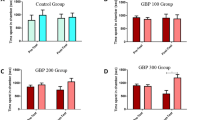Abstract
Rationale: The rewarding properties of Δ9- tetrahydrocannabinol (THC) are difficult to demonstrate in rodents using standard procedures. Objective: To evaluate the motivational responses of THC in the place conditioning paradigm in mice after minimizing the dysphoric effects of the first drug exposure and/or the consequences of its pharmacokinetic properties. Methods: Mice were conditioned to THC (1 or 5 mg/kg) using an unbiased procedure with an elevated number of pairings and long conditioning time. Results: A place aversion was observed with 5 mg/kg THC using a standard protocol. Similar results were obtained when the CB-1 receptor antagonist SR 141716A (1 mg/kg) was administered immediately after each THC conditioning period. However, mice receiving a priming THC injection and conditioned 24 h later showed a place preference with 1 mg/kg THC and no effect with 5 mg/kg THC. Conclusion: THC produces a clear place preference in mice by using a long period of conditioning and avoiding the possible dysphoric consequences of the first drug exposure.
Similar content being viewed by others
Author information
Authors and Affiliations
Additional information
Received: 12 August 1999 / Final version: 28 September 1999
Rights and permissions
About this article
Cite this article
Valjent, E., Maldonado, R. A behavioural model to reveal place preference to Δ9-tetrahydrocannabinol in mice. Psychopharmacology 147, 436–438 (2000). https://doi.org/10.1007/s002130050013
Issue Date:
DOI: https://doi.org/10.1007/s002130050013




